- History / Culture
- Traditions / Performing Arts
No.f_0026
Exploring Fashion through “Made in Japan”
After the opening of Kobe Port in 1868, tailors introduced Western-style clothing, and the city nurtured a refined fashion culture. Alongside it grew a spirit and style rooted in the idea of “cherishing good quality items for a long time.” In Kobe, “Made in Japan” refers not only to technique but also to that very spirit. Even in today’s world of fast fashion, walking through Kobe and Kojima in Okayama Prefecture is a journey into the question: what does fashion truly mean?
A Museum that Gives Form to a Fashion City Statement
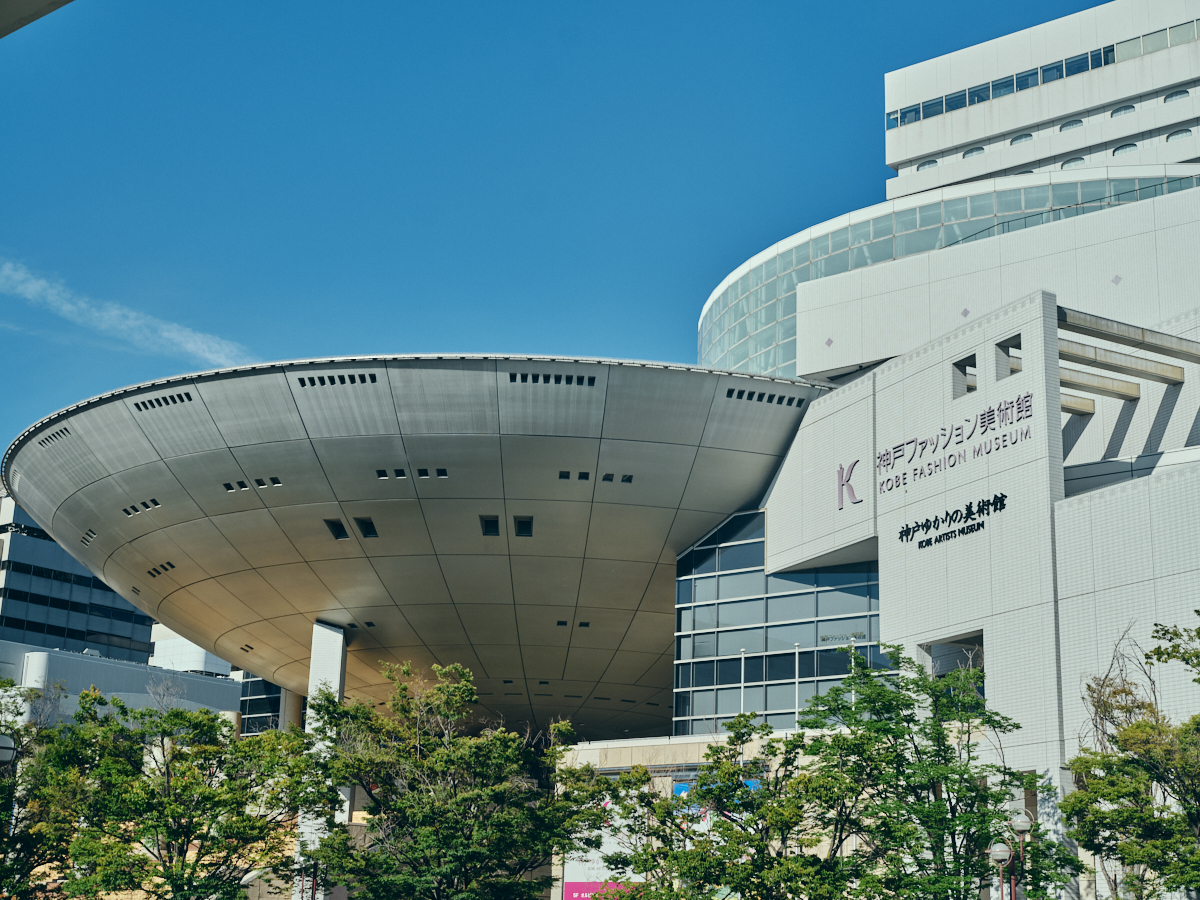 The disc-shaped section is a hall where fashion shows and other events are held.
The disc-shaped section is a hall where fashion shows and other events are held.
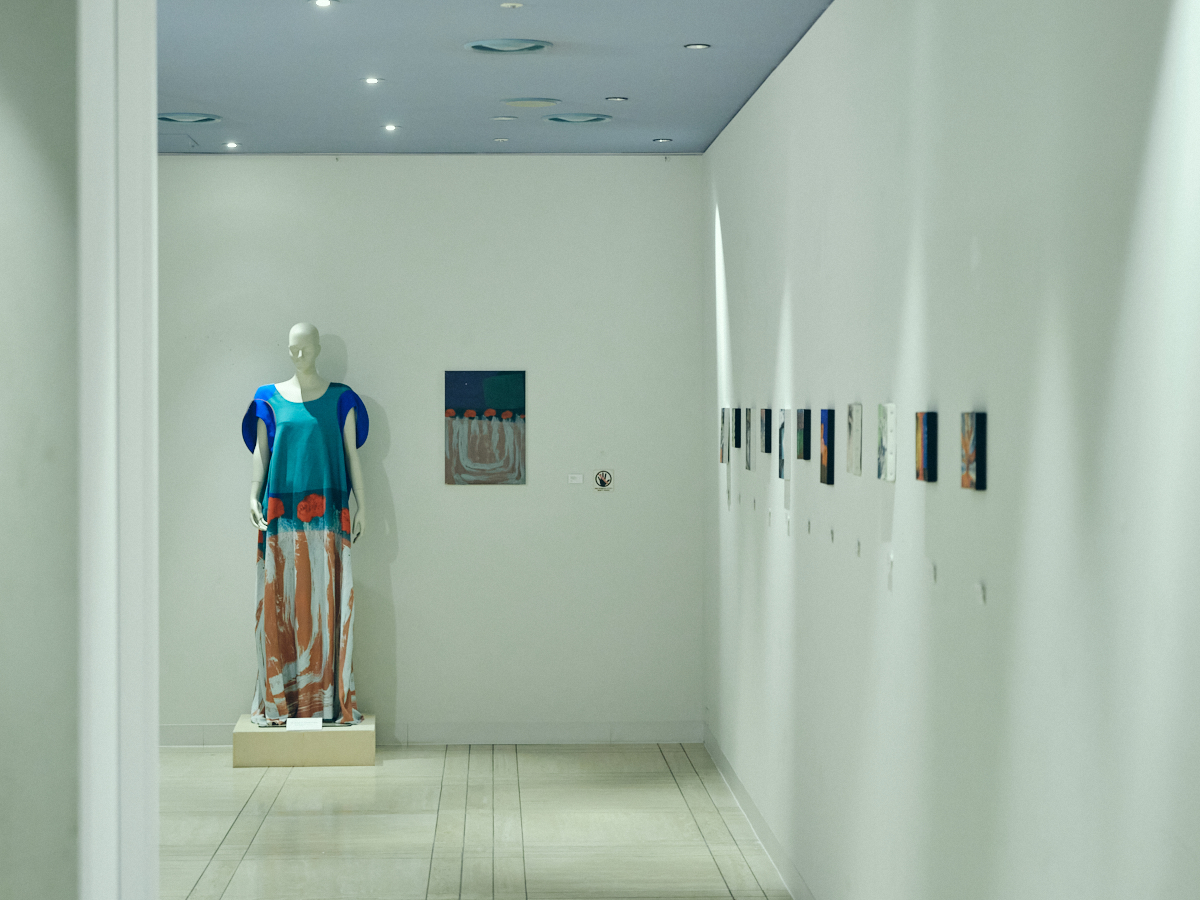 The KH FASHION BOX, a corner showcasing the work of honorary director Hiroko Koshino.
The KH FASHION BOX, a corner showcasing the work of honorary director Hiroko Koshino.
Kobe declared itself a Fashion City in 1973.
To give concrete form to that vision, the Kobe Fashion Museum opened in 1997. It was Japan’s first public museum dedicated to fashion, presenting exhibitions on Western and ethnic costumes from the 18th century onward, as well as hosting special exhibitions. For Kobe, fashion is not limited to clothing, but touches all aspects of life—food, housing, leisure, and the broader lifestyle industries. A visit here is also a chance to reflect on daily life.
The museum library makes available some 45,000 volumes of fashion-related books from Japan and abroad, as well as back issues of fashion magazines dating from the early 20th century. It has become a valuable place of study for students and young designers.
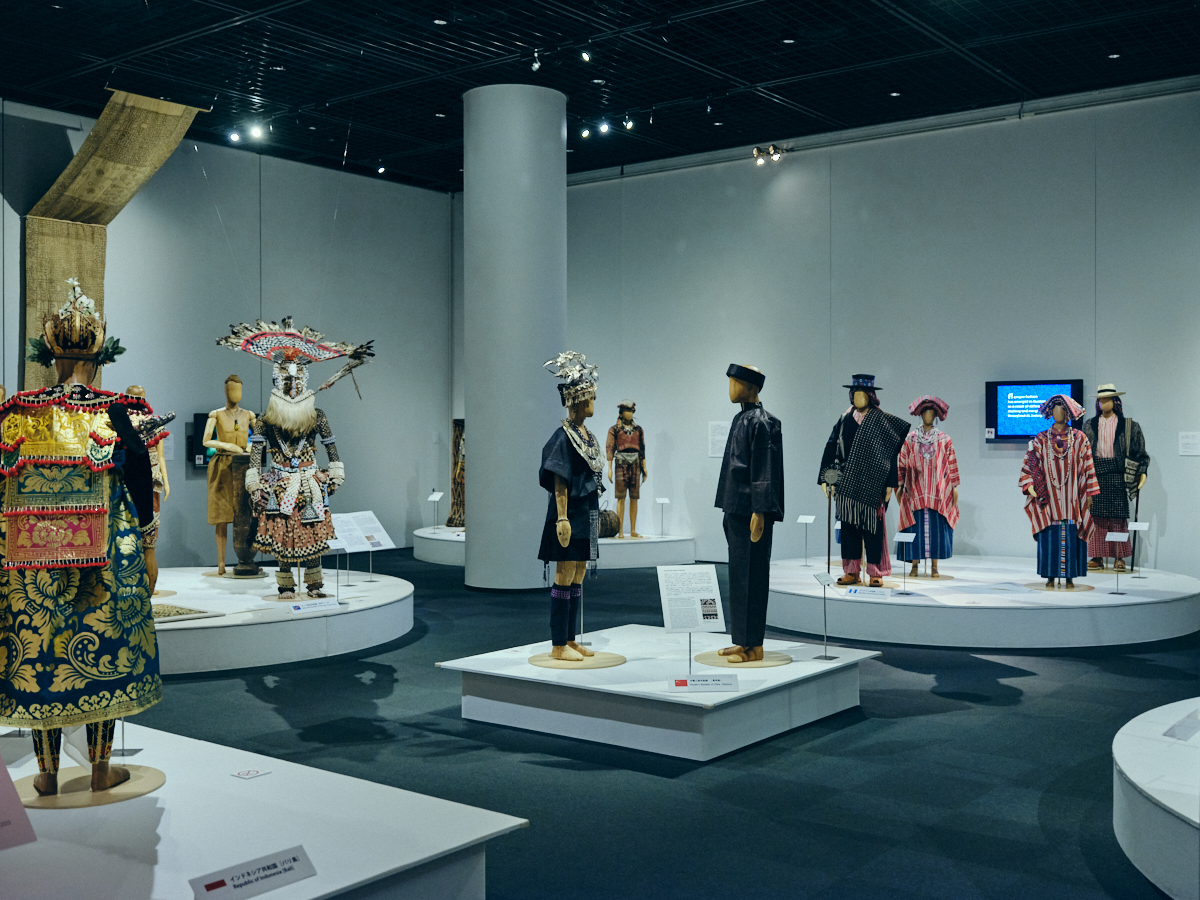 “The Festival: Festivals and Dance Costumes from Around the World,” a dress collection exhibition held in the summer of 2025.
“The Festival: Festivals and Dance Costumes from Around the World,” a dress collection exhibition held in the summer of 2025.
When visiting Kobe, Kobe Airport—conveniently connected to the city center—makes for an easy entry point.
A Select Shop that Sustains Kobe’s “Basics”
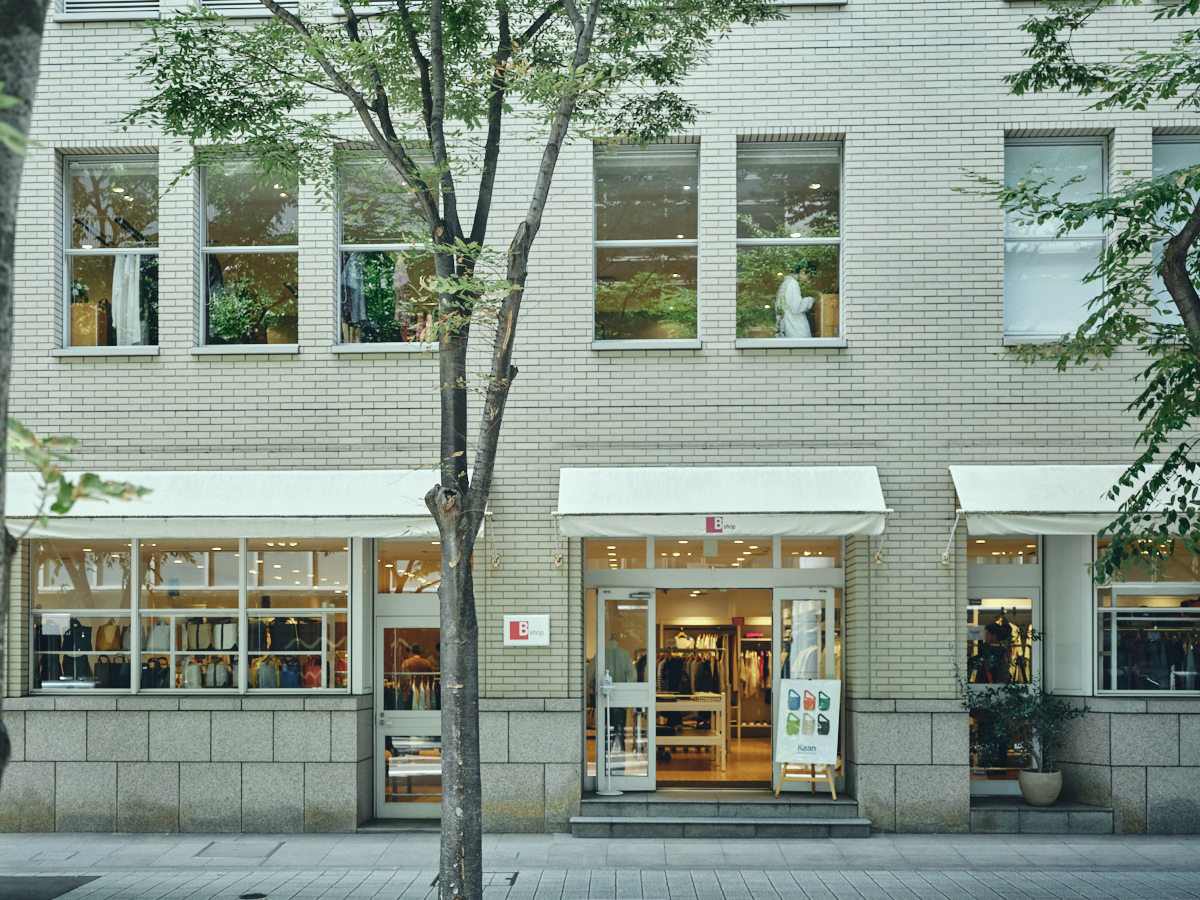 The first Bshop store, located in Kobe’s Chuo Ward.
The first Bshop store, located in Kobe’s Chuo Ward.
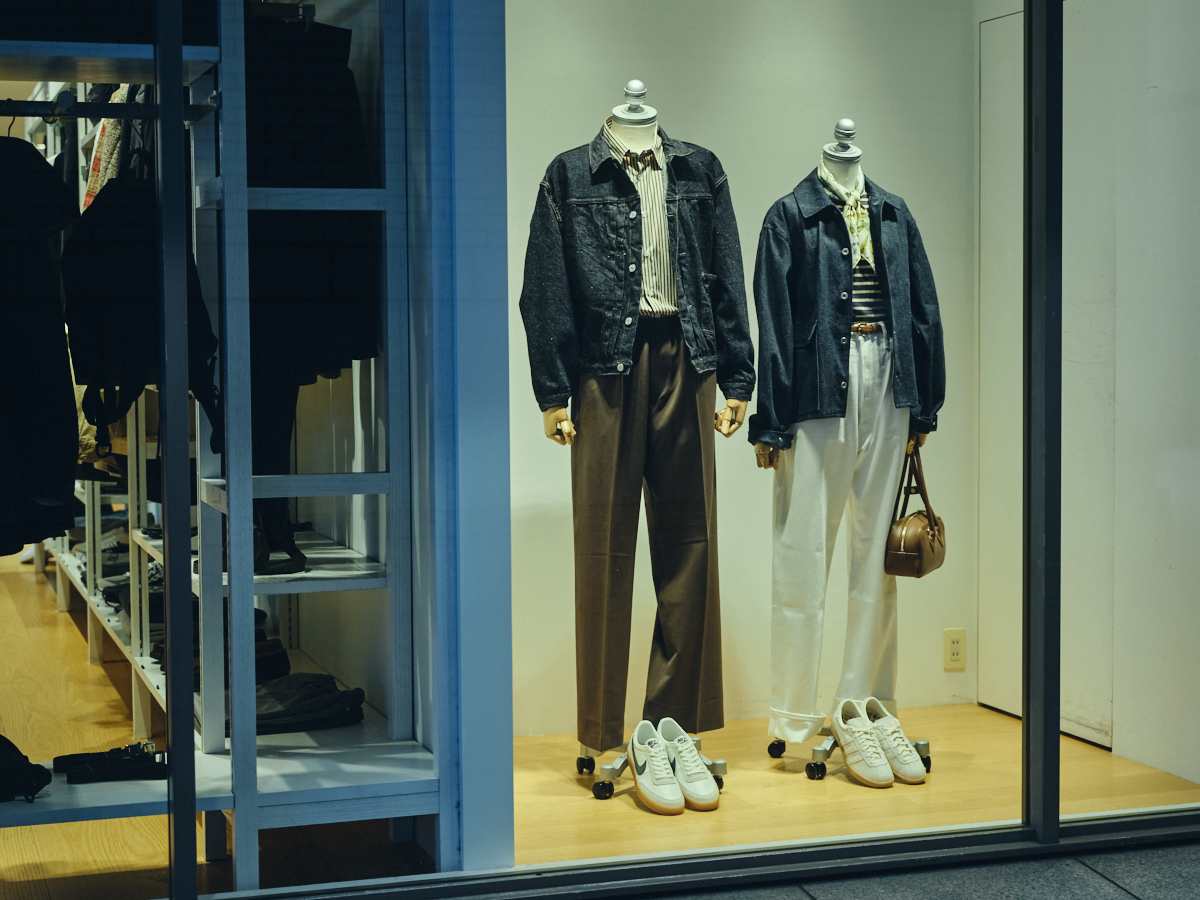 The shop window displays seasonal coordinated looks.
The shop window displays seasonal coordinated looks.
Founded in Kobe in 1994, the select shop Bshop has spent three decades offering what it calls “the best in the ordinary” through timeless brands such as Danton, Orcival, and Gymphlex.
At the time of its founding, Bshop embraced the concept of “making street interesting” by carrying avant-garde labels. But when the Great Hanshin-Awaji Earthquake struck in 1995, the shop provided clothes to people affected by the disaster. That experience highlighted the importance of everyday wear, which has since become the foundation of its philosophy.
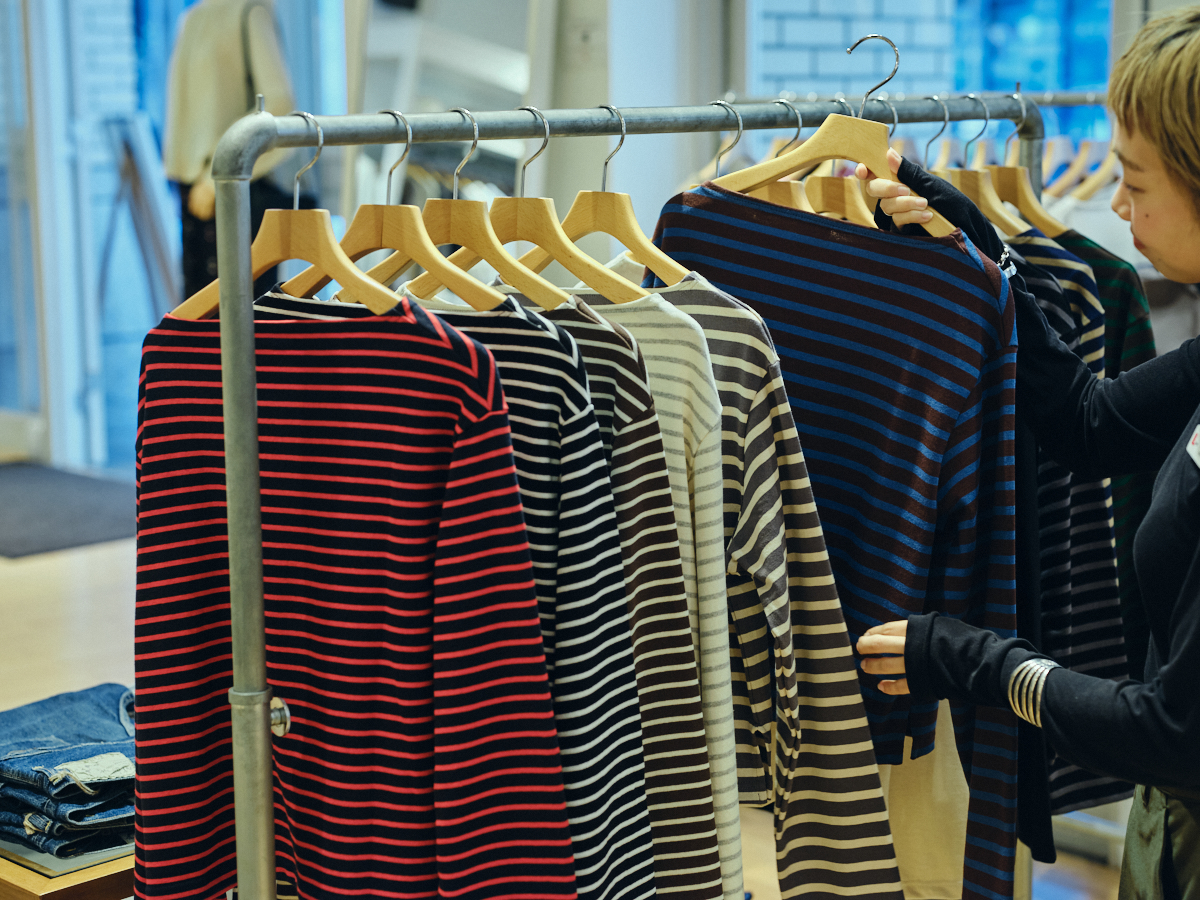 Orcival once supplied uniforms to the French Navy in the 1950s–60s.
Orcival once supplied uniforms to the French Navy in the 1950s–60s.
Take, for example, Orcival’s cut-and-sew shirts: tough, versatile items that suit any style, regardless of age or gender. Their longevity is backed by Orcival’s history, dating back to its founding in 1939. Store manager Akane Tahara notes, “I can recommend them with confidence, because I still wear pieces I bought 10 years ago.”
Yuka Ozawa from the marketing team adds, “In Kobe, you often see children wearing clothing passed down from their mothers. It’s only possible because the items are of such high quality. That’s the kind of fashion we want to continue supporting here in Kobe.”
Today, Bshop operates 43 stores across Japan and has just opened its first overseas branch in South Korea. Its idea of “the best in the ordinary” is already attracting attention there as well.
Kobe Airport is also set to begin regular charter flights to South Korea, Taiwan, and China in spring 2025, making access to the city even easier.
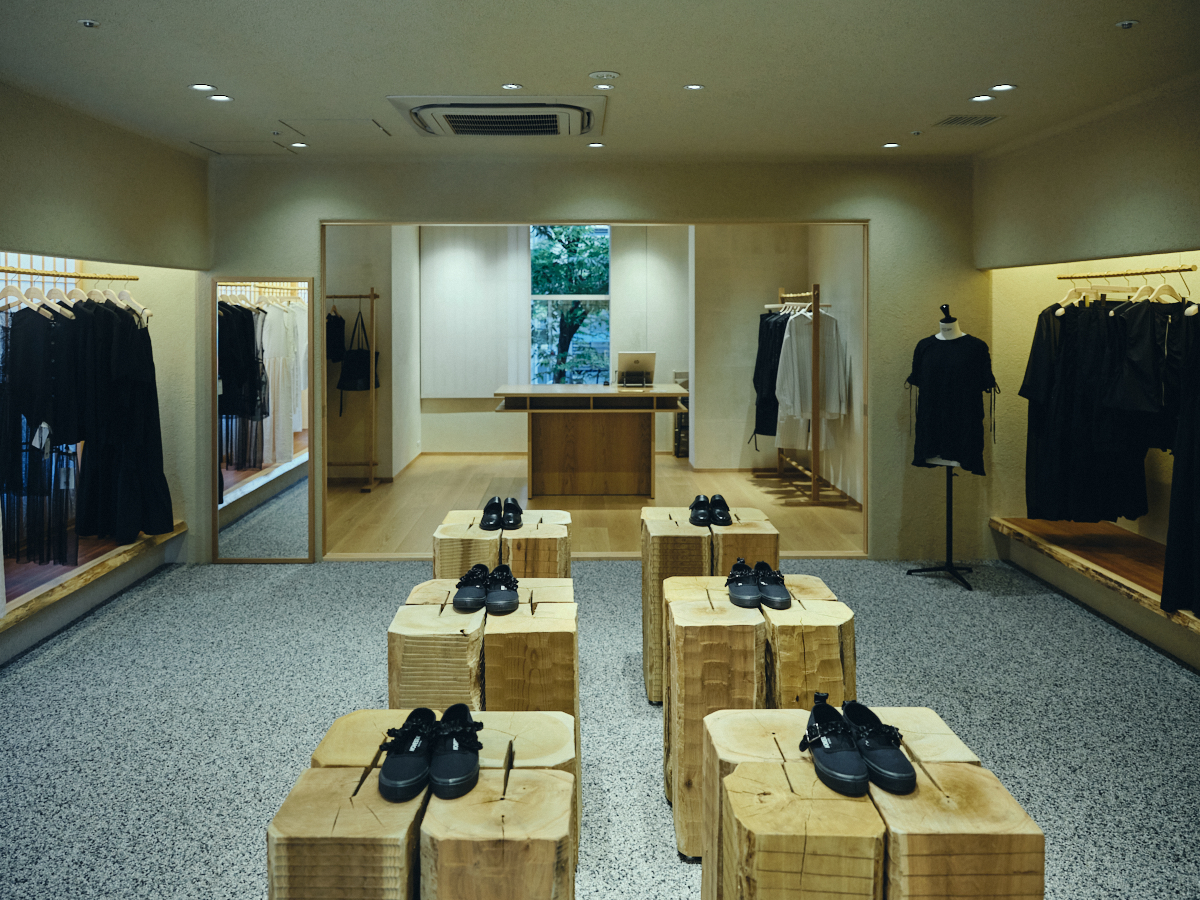 Curves incorporated into the fixtures echo the identity of the brands on display.
Curves incorporated into the fixtures echo the identity of the brands on display.
Last year, Korean brand eunoia, also carried by Bshop, opened its first flagship store in Japan on the shop’s second floor. The brand takes inspiration from curves found in Korean sculpture, architecture, and ceramics, while the interior design integrates traditional Japanese materials—a space where two design traditions meet.
What’s Next for a Sports Shoe Beloved by Athletes Around the World
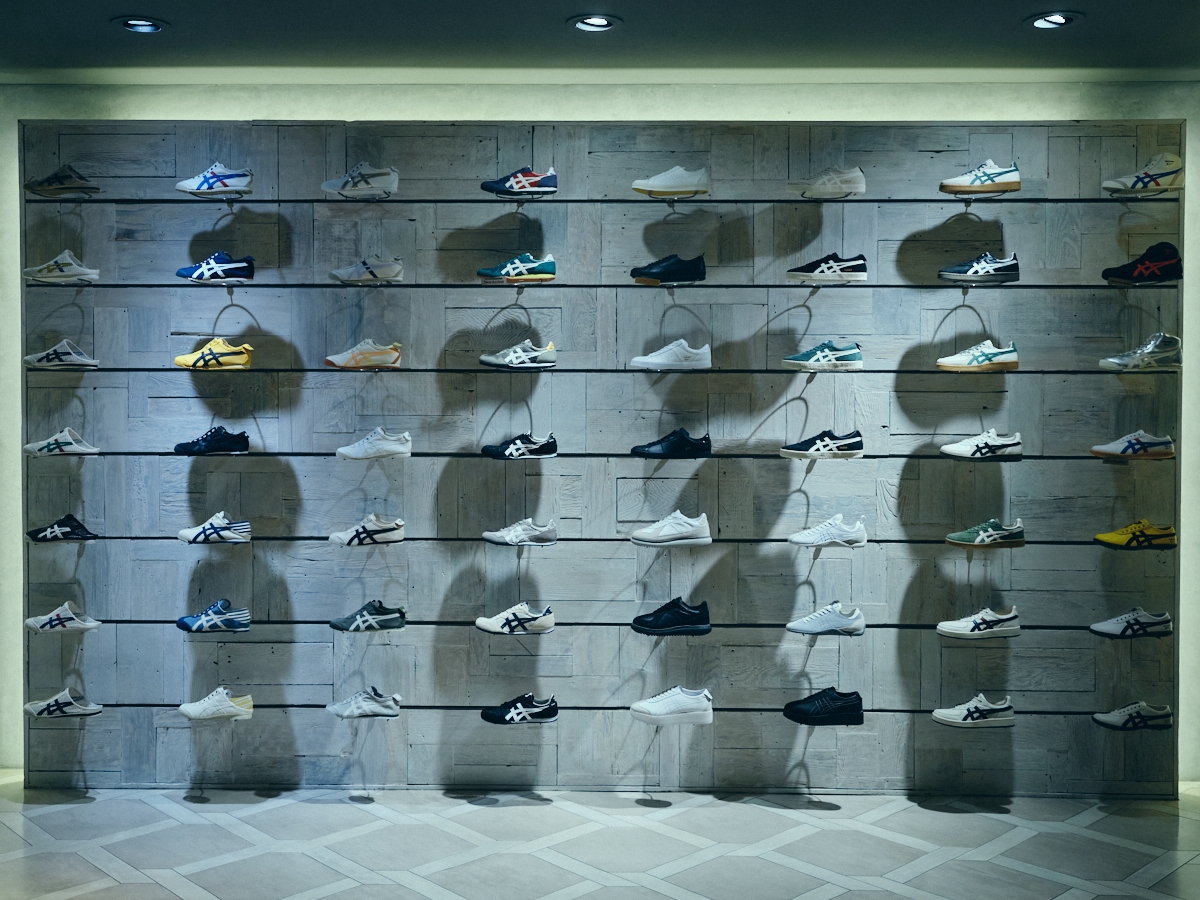
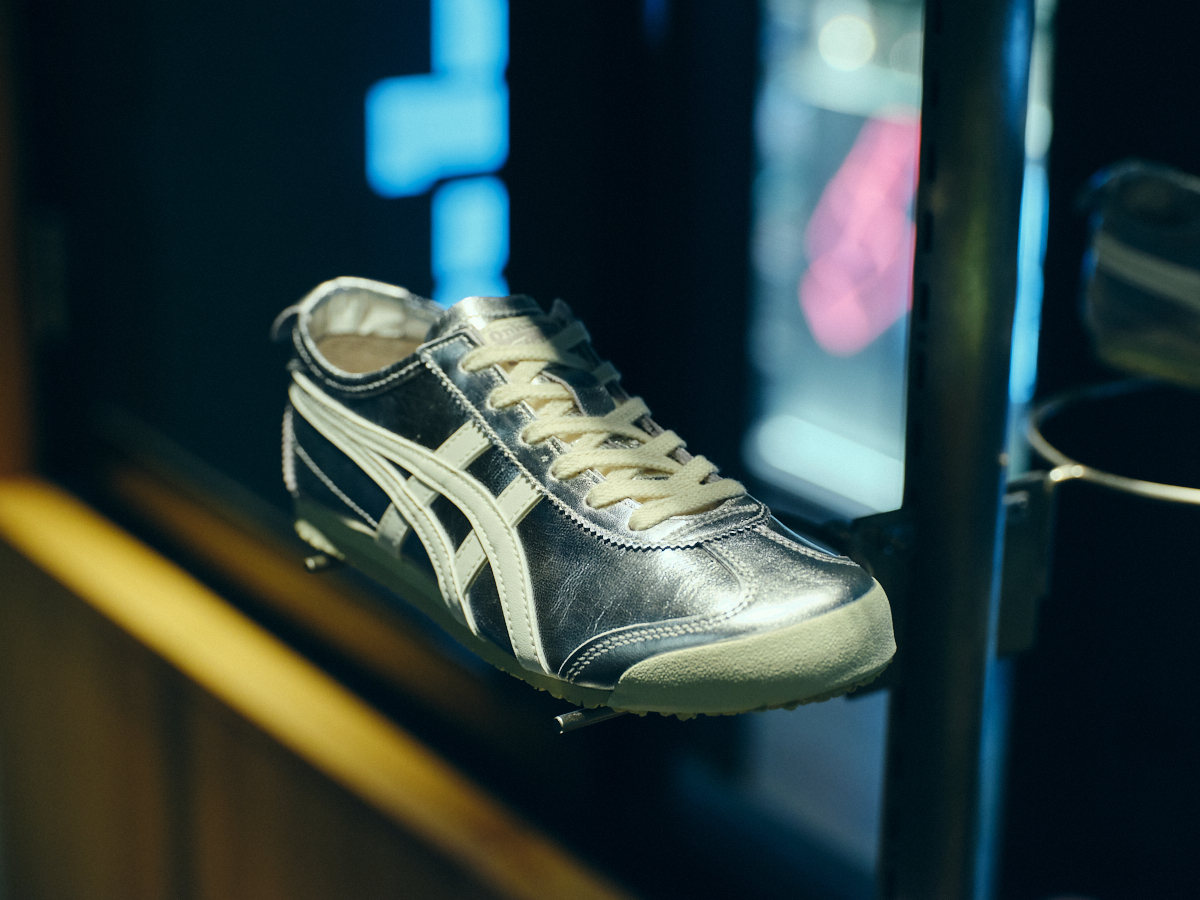 MEXICO 66 series. Metallic colors elevate any look.
MEXICO 66 series. Metallic colors elevate any look.
Among the fashion brands that originated in Kobe is Onitsuka Tiger.
Founded in 1949 as a sports shoe manufacturer, the brand developed models for basketball, marathon running, and other competitions. At the 1964 Tokyo Olympics, athletes wearing Onitsuka Tiger shoes delivered standout performances, earning the label global fame as “the world’s Onitsuka Tiger.” After a hiatus from 1977 to 2002, the brand was revived—just as the craze for high-tech sneakers was waning and retro styles were back in vogue. That same year, the release of the MEXICO 66 series struck a chord, becoming a hit and remaining a flagship design to this day. The line was inspired by a model developed for the 1968 Mexico City Olympics. With its return, Onitsuka Tiger once again stepped onto the world stage.
The slim silhouette and variety of materials make MEXICO 66 a versatile match for everything from casual wear to suits, gaining popularity not only in Japan but internationally. Behind this enduring appeal lies not just design but also technical refinement: today’s MEXICO 66 series features insoles with excellent rebound, supporting a comfortable fit.
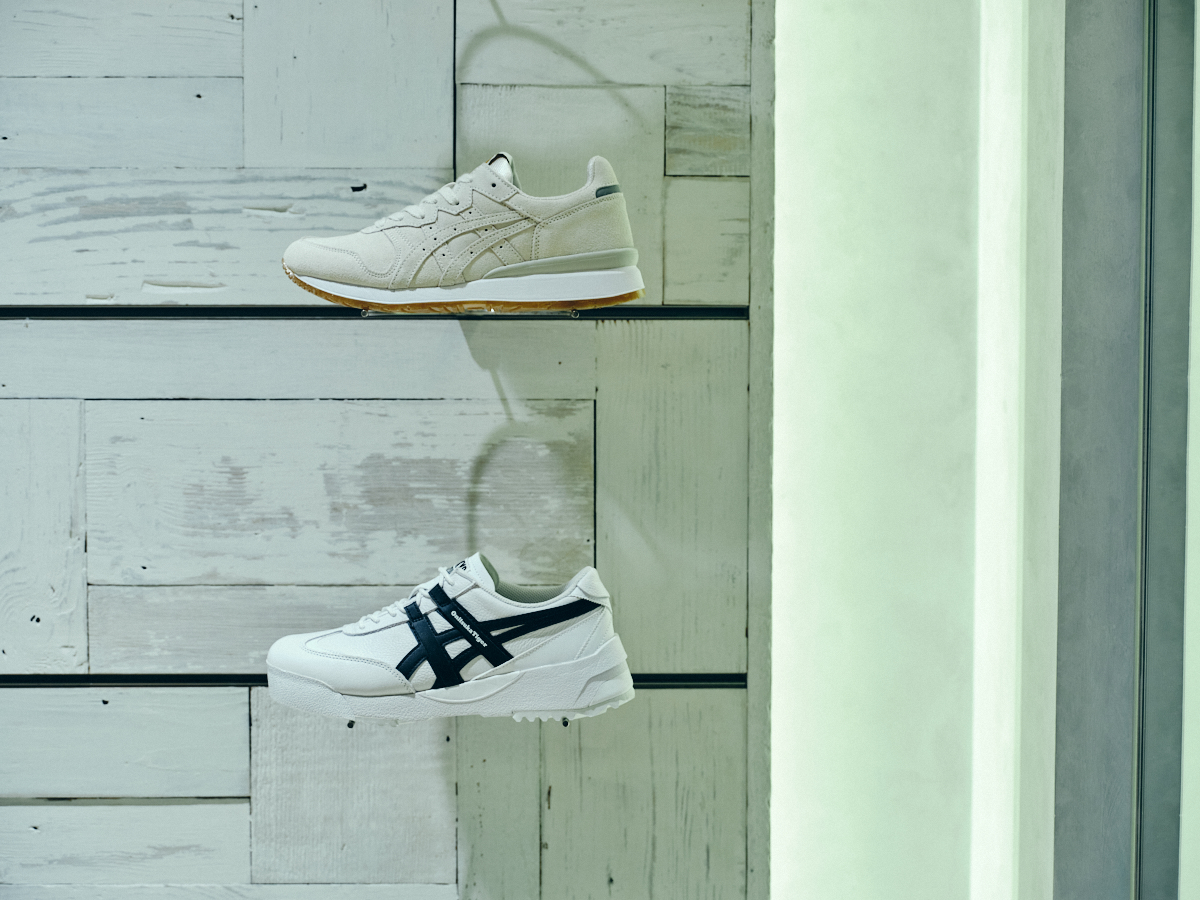 The TIGER ALLY (top), evolved from the 1980s ALLIANCE, among others.
The TIGER ALLY (top), evolved from the 1980s ALLIANCE, among others.
The success of founder Kihachiro Onitsuka is said to have been shaped by the influx of Western culture and industry through Kobe Port, as well as by the city’s flourishing rubber industry. From these roots, Onitsuka Tiger spread its wings to the world.
Even its iconic stripes are thought by some to be inspired by the waves of Kobe Harbor.
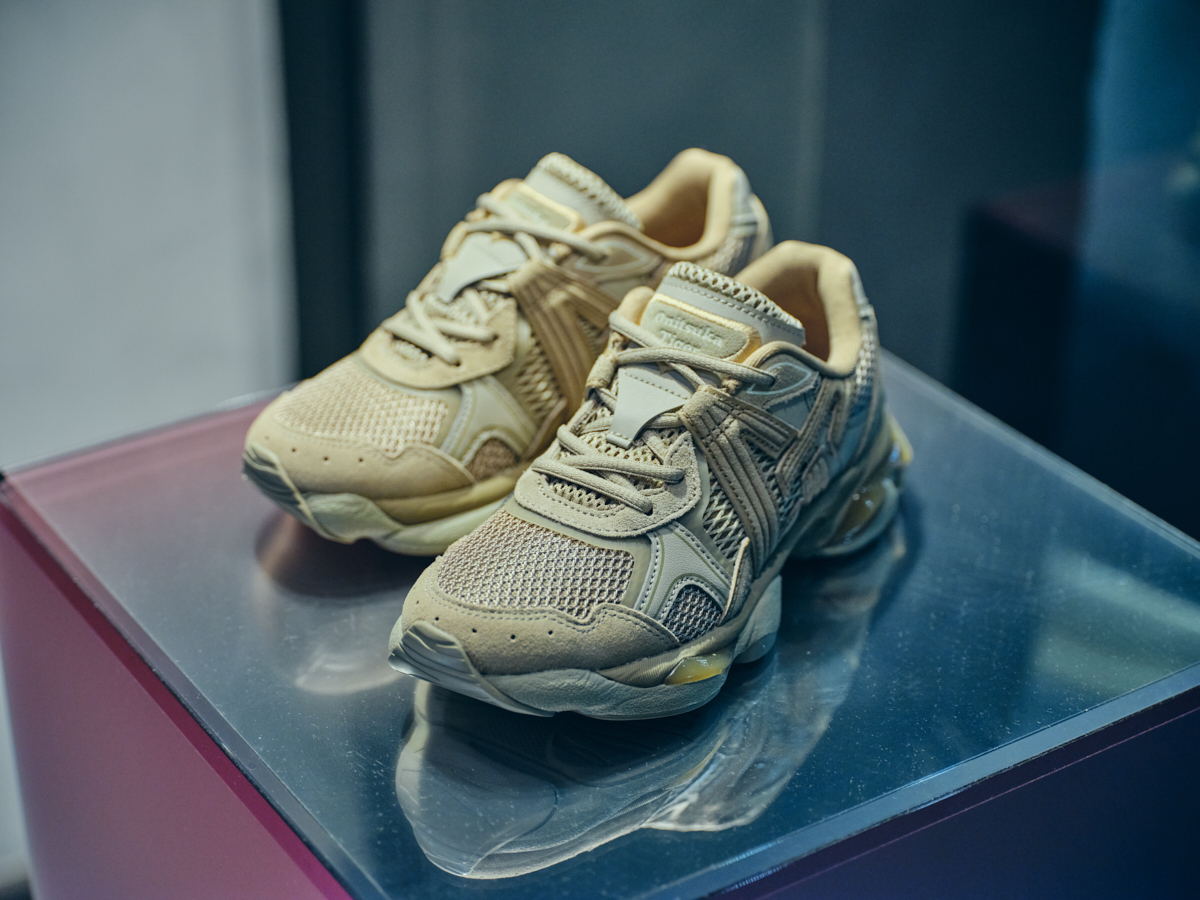 TIGRUN, released in August this year.
TIGRUN, released in August this year.
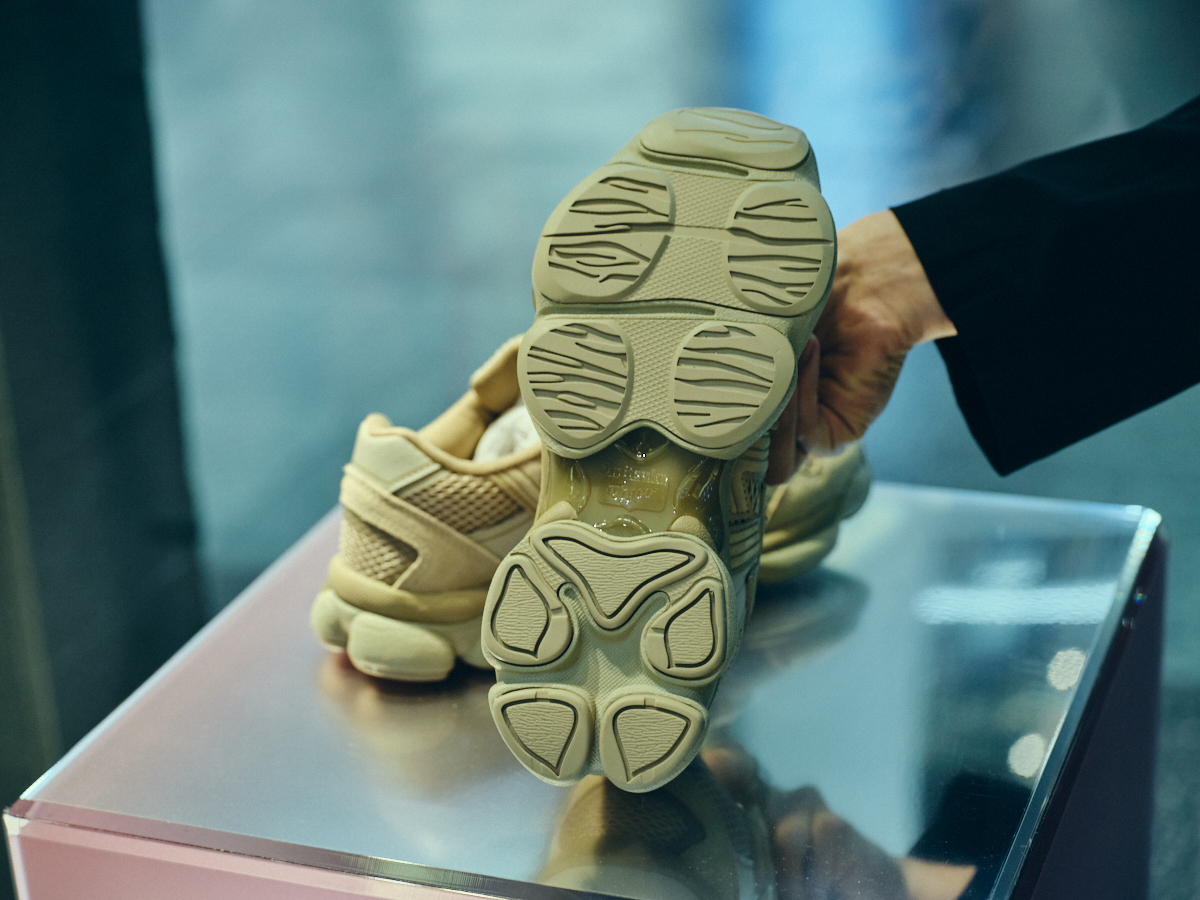 Tiger stripes and paw prints adorn the outer sole.
Tiger stripes and paw prints adorn the outer sole.
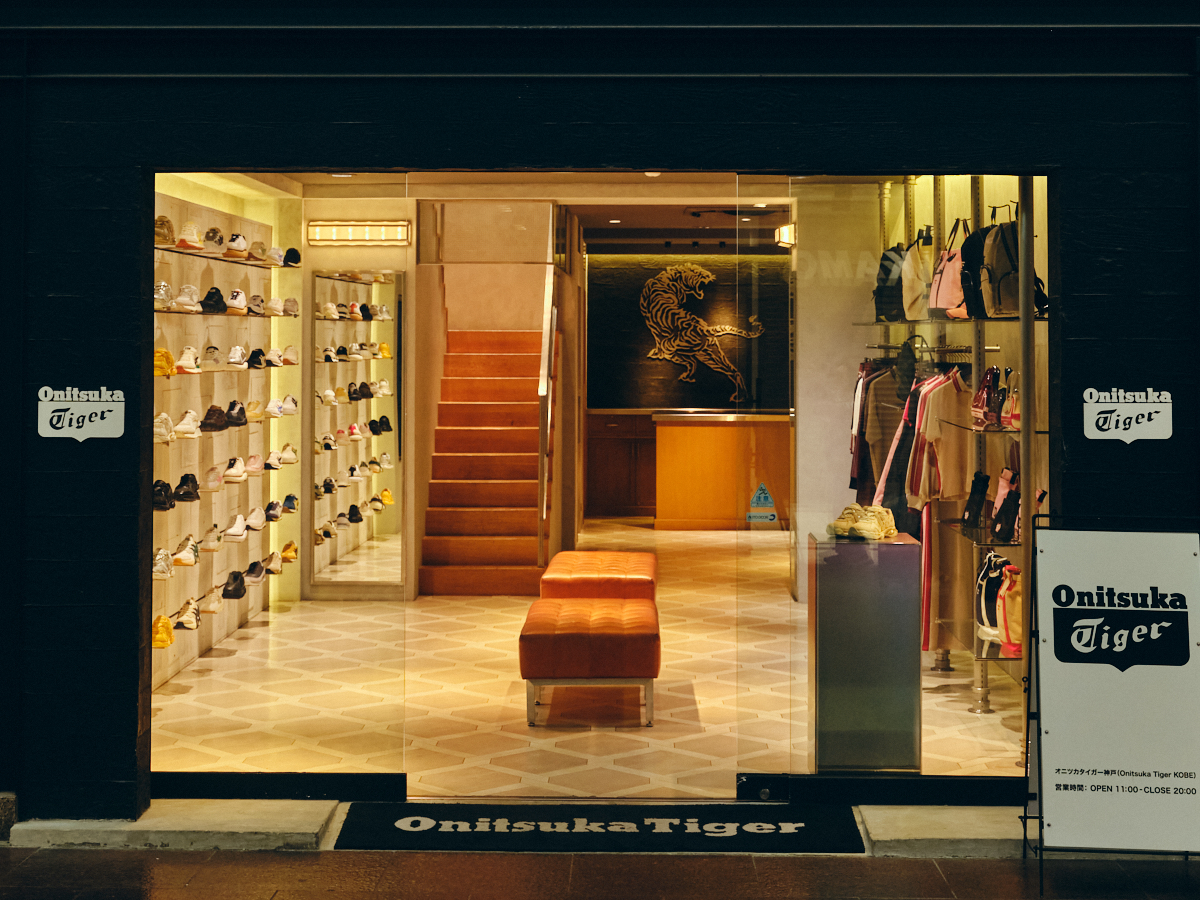 The Onitsuka Tiger Kobe store, located in Sannomiya.
The Onitsuka Tiger Kobe store, located in Sannomiya.
Experiencing Japanese Craftsmanship Through Converse
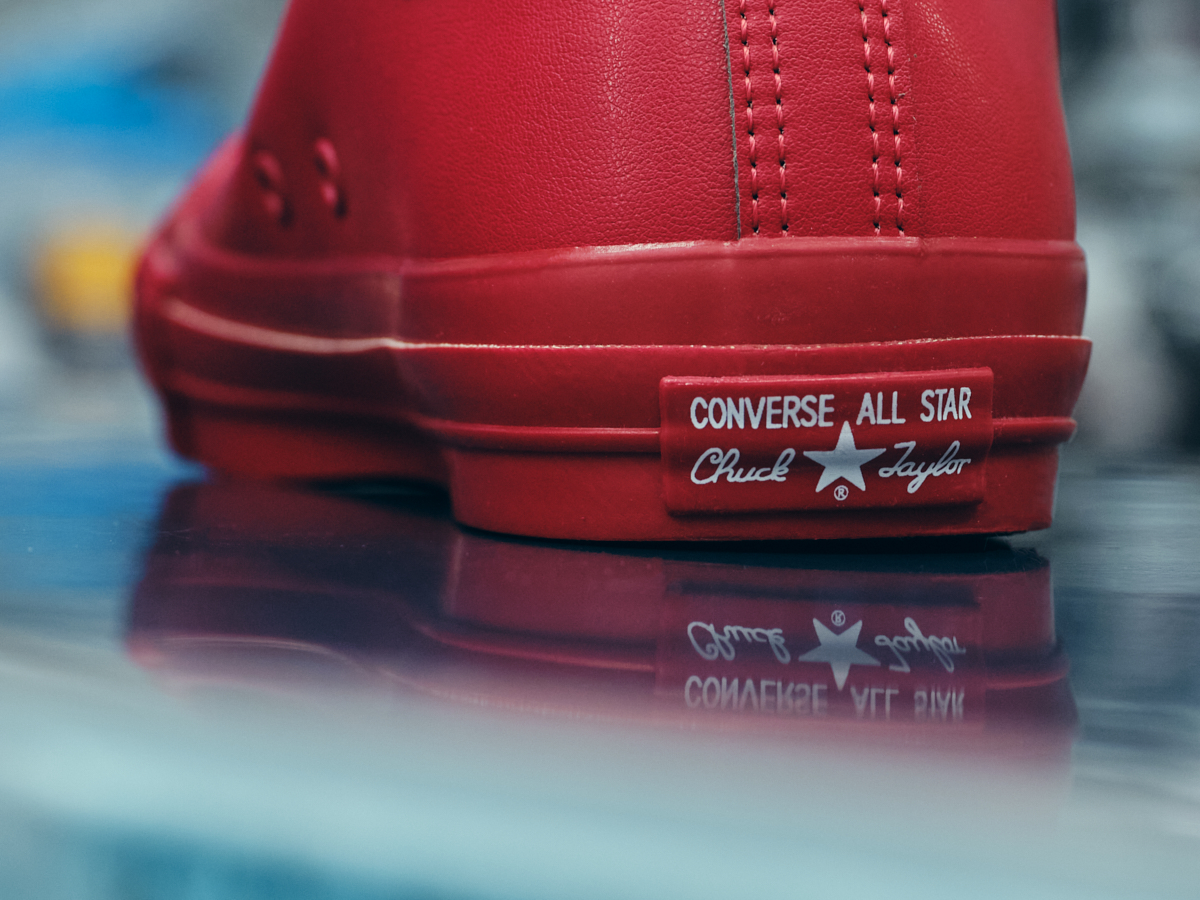 All Star sneakers made with Clarino, an artificial leather originally developed in Japan for traditional school backpacks (randoseru).
All Star sneakers made with Clarino, an artificial leather originally developed in Japan for traditional school backpacks (randoseru).
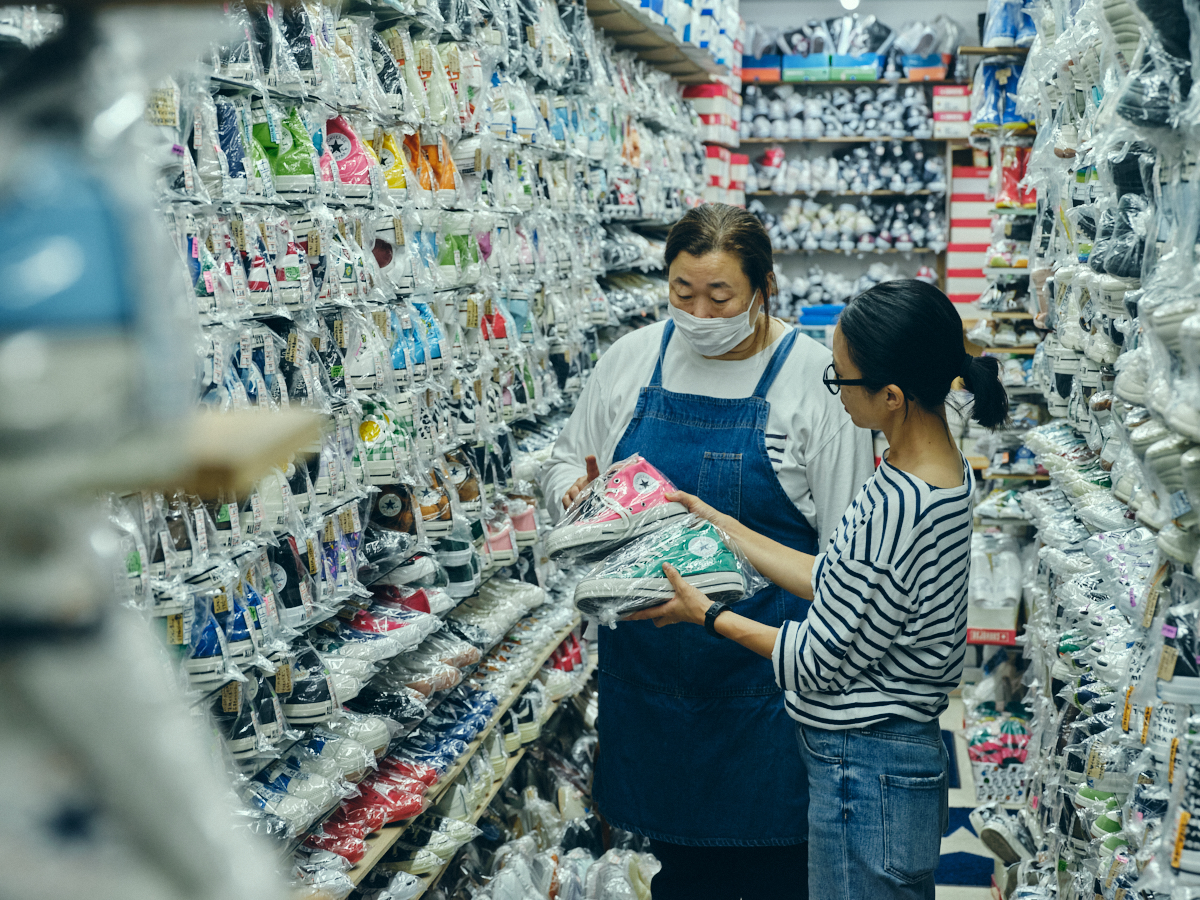 Shu’s daughter, Kanae Kakimoto.
Shu’s daughter, Kanae Kakimoto.
At Kakimoto Shoten, Converse sneakers embody the spirit of Japanese craftsmanship in every detail.
Located in Kobe’s Motomachi Shopping Street, Kakimoto Shoten is a shoe store founded in 1968. The shelves are lined wall-to-wall with Converse. President Shunyo Shu once worked exporting shoes overseas for Japan’s “big three” makers—MoonStar, Asahi Shoes, and Secaicho Union. Japanese-made shoes, renowned for their quality, were well received abroad, but when the strong yen forced him to shift business direction in the 1980s, Kakimoto turned the shop into a Converse specialty store. A turning point came in 2000, when the U.S. Converse company filed for bankruptcy. Hearing the news, Shu was convinced: “From here, Converse will only gain in value and popularity.” Acting on that belief, he purchased around 20,000 pairs. His intuition proved right—customers from across Japan and abroad began flocking to Kakimoto Shoten in search of Converse.
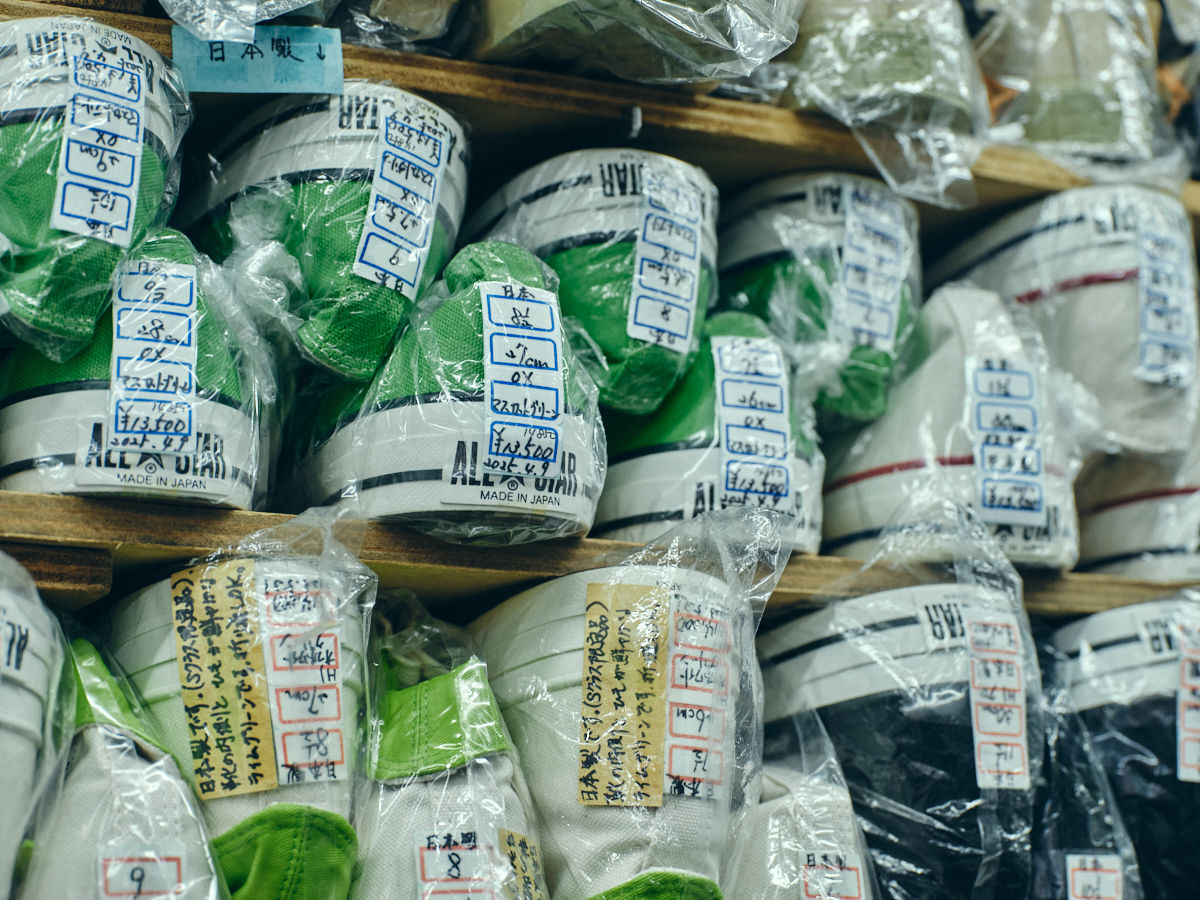 Each item is tagged with size, price, and handwritten notes by Kanae Kakimoto.
Each item is tagged with size, price, and handwritten notes by Kanae Kakimoto.
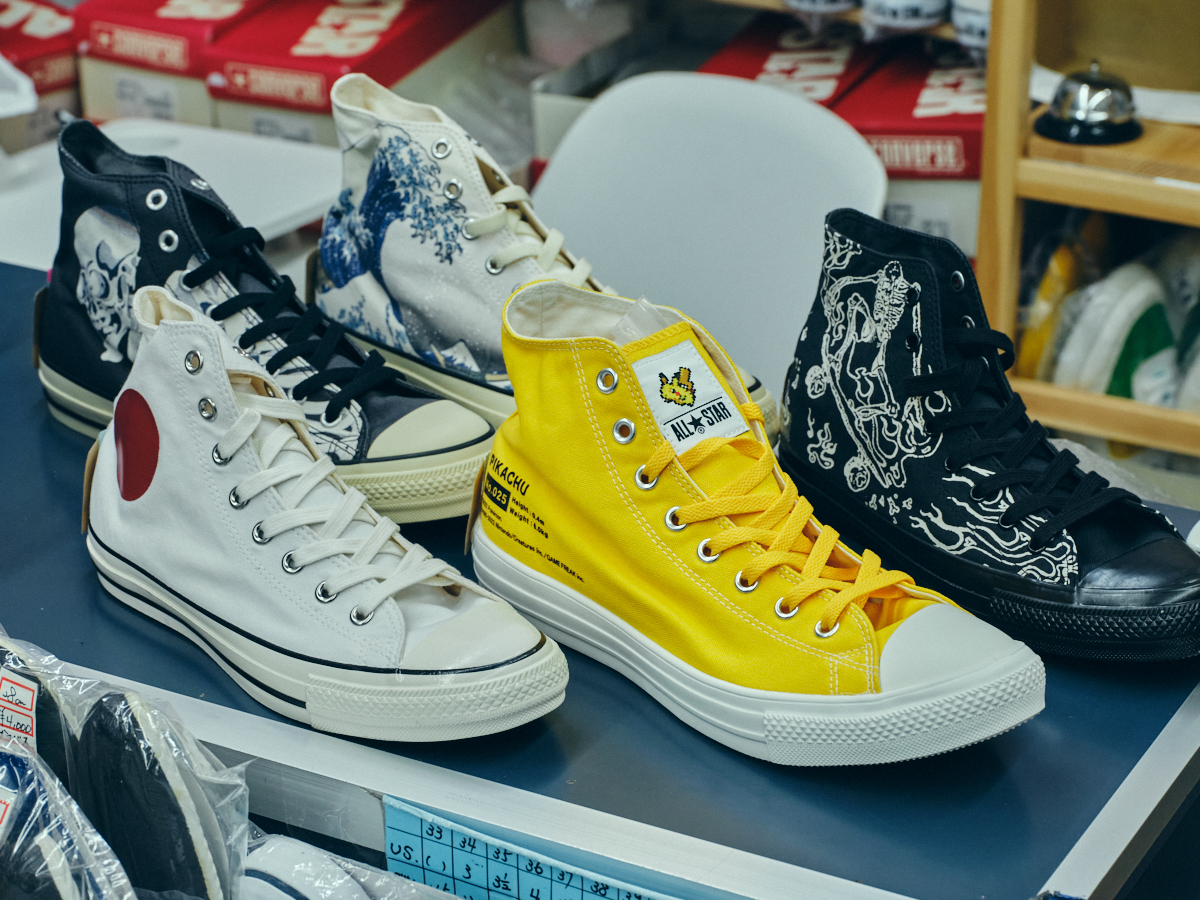 Japan-only designs are also popular.
Japan-only designs are also popular.
Some Converse sneakers are made in Japan at the MoonStar factory. The mark of authenticity is the “MADE IN JAPAN” lettering on the heel logo. Crafted from flexible canvas and high-quality rubber, these models mold comfortably to the foot and reduce fatigue. They’re especially sought after by devoted Converse fans who enjoy owning pairs that stand apart from the global lineup.
Learning from the Past with Vintage
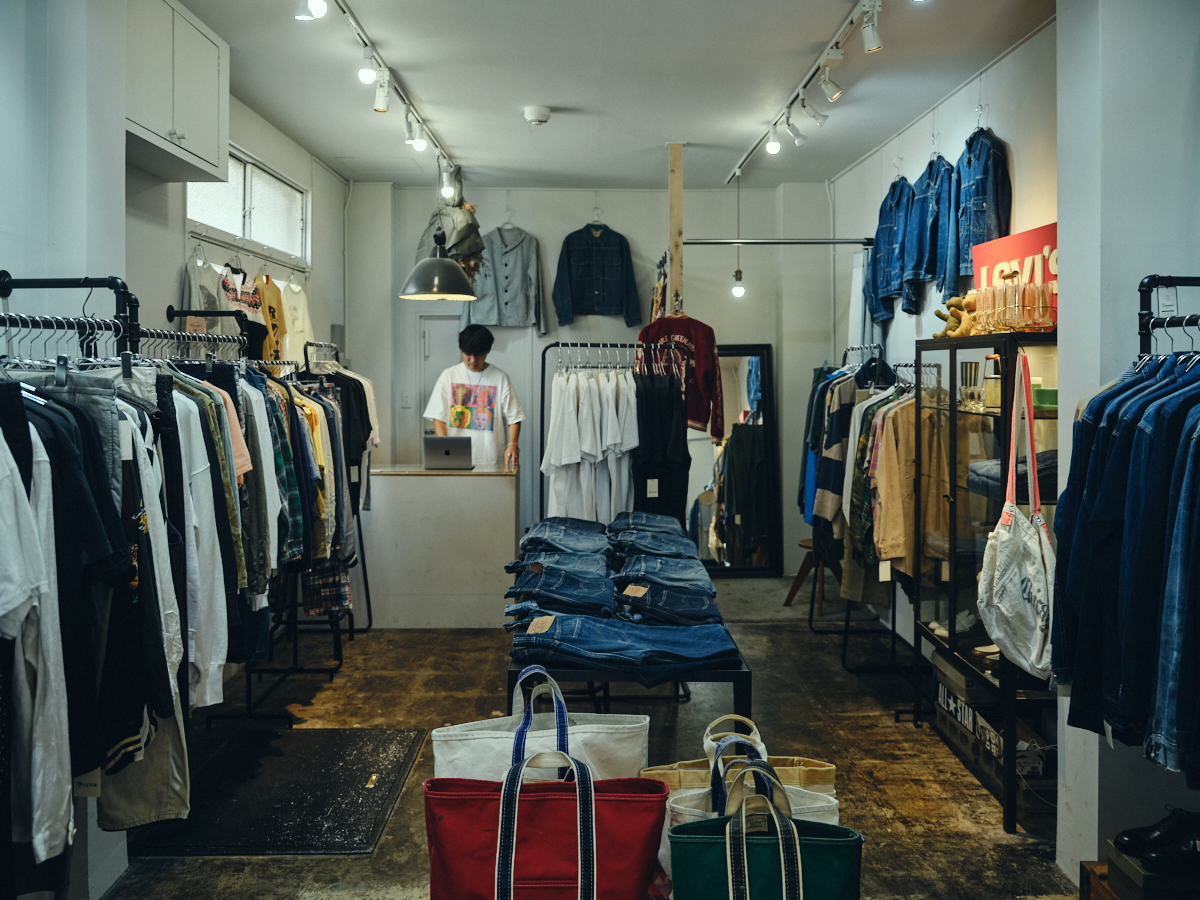 Inside the shop, items curated through Tetsuya Shimada’s “filter” are on display.
Inside the shop, items curated through Tetsuya Shimada’s “filter” are on display.
The vintage boom that swept Japan in the 1990s drew pieces from all over the world to the country. In Kobe, one place where vintage lives on is FILTER, a select shop run by Tetsuya Shimada. Shimada insists on in-person retail. His reason? To bring vibrancy to the city streets and to give back to the Kobe community where he was born and raised.
FILTER’s signature items are denim. Think 1940s denim jackets made for Montgomery Ward department store in the U.S., or Levi’s with leather patches. Though FILTER only opened in 2022, Shimada has built international sourcing routes, and his deep knowledge and passion for vintage have quickly gained recognition. Customers come not only from across Japan but from overseas as well, drawn by his curation.
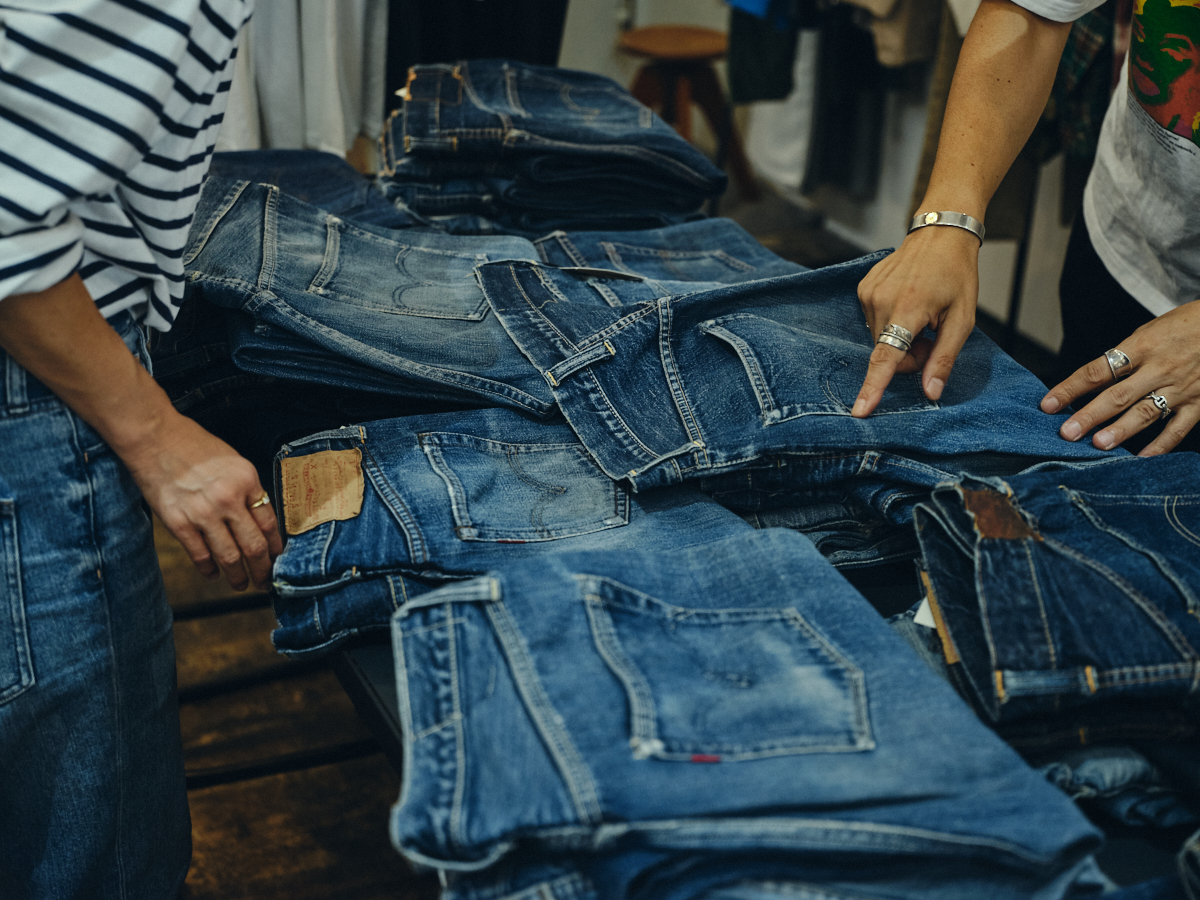 From the stitching, you can read the history behind the jeans.
From the stitching, you can read the history behind the jeans.
 First and second model Levi’s denim jackets.
First and second model Levi’s denim jackets.
“The appeal of denim is that it goes with anything, it’s durable because of its roots as workwear, and even when it’s worn down, that wear becomes part of its charm. It’s like a watch that accompanies you through life,” says Shimada. His words reflect Kobe’s enduring spirit of cherishing good quality items for a long time. FILTER also provides after-sales care for purchased items.
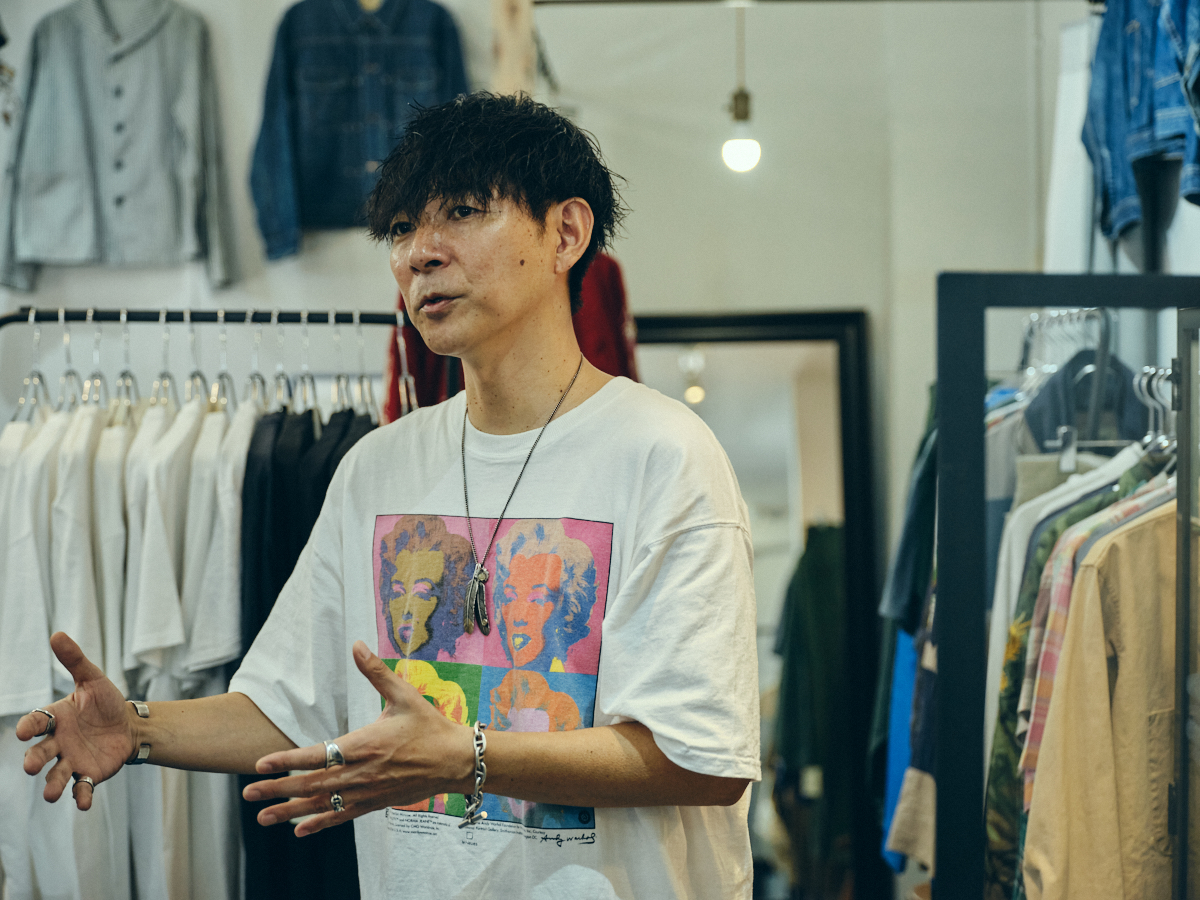 Shimada first discovered vintage as a high school student.
Shimada first discovered vintage as a high school student.
From the fade of the indigo dye, experts can tell the era and country where jeans were produced, even the body type of the person who wore them. The way these details affect market value is fascinating, but Shimada emphasizes something else: “No two vintage items are alike. Just choosing one is enough to enjoy them. The only measure should be whether you find it cool.” He continues: “Add just one vintage piece to your look, and it creates a style that’s uniquely yours. That’s the fun of vintage. Discover a new side of yourself.”
At FILTER, the world of vintage feels just a little closer.
BOOK YOUR STAY IN KOBE
Kojima, the Birthplace of Japanese Jeans
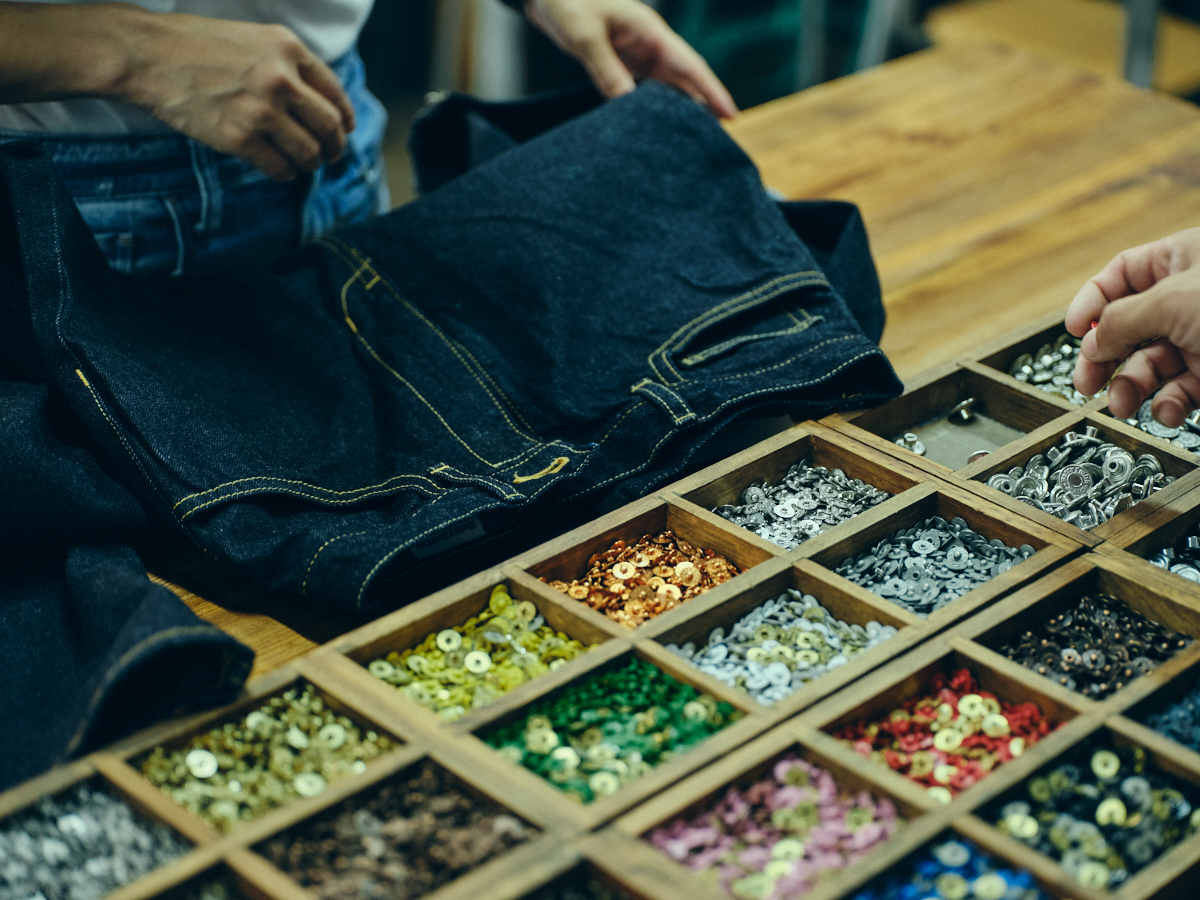 Jeans-making experience at the Betty Smith Jeans Museum & Village.
Jeans-making experience at the Betty Smith Jeans Museum & Village.
From Kobe, it takes about two hours by Shinkansen to reach Kurashiki in Okayama Prefecture, home to Kojima, the cradle of domestic jeans production in Japan.
Kojima was once reclaimed land, where cotton resilient to salt was cultivated from the Edo period onward, fueling the growth of its textile industry. For a time, Kojima boasted the largest share in Japan for producing school uniforms. But as synthetic fibers grew in demand, local makers turned to jeans as a new path forward. The very first jeans made in Japan were produced here in 1965.
What began with cotton cultivation eventually evolved into a hub where spinning, dyeing, sewing, and denim processing factories now cluster. Skills honed and handed down through generations of craftspeople from Kojima’s textile past continue to flourish today, attracting even the attention of luxury brands overseas.
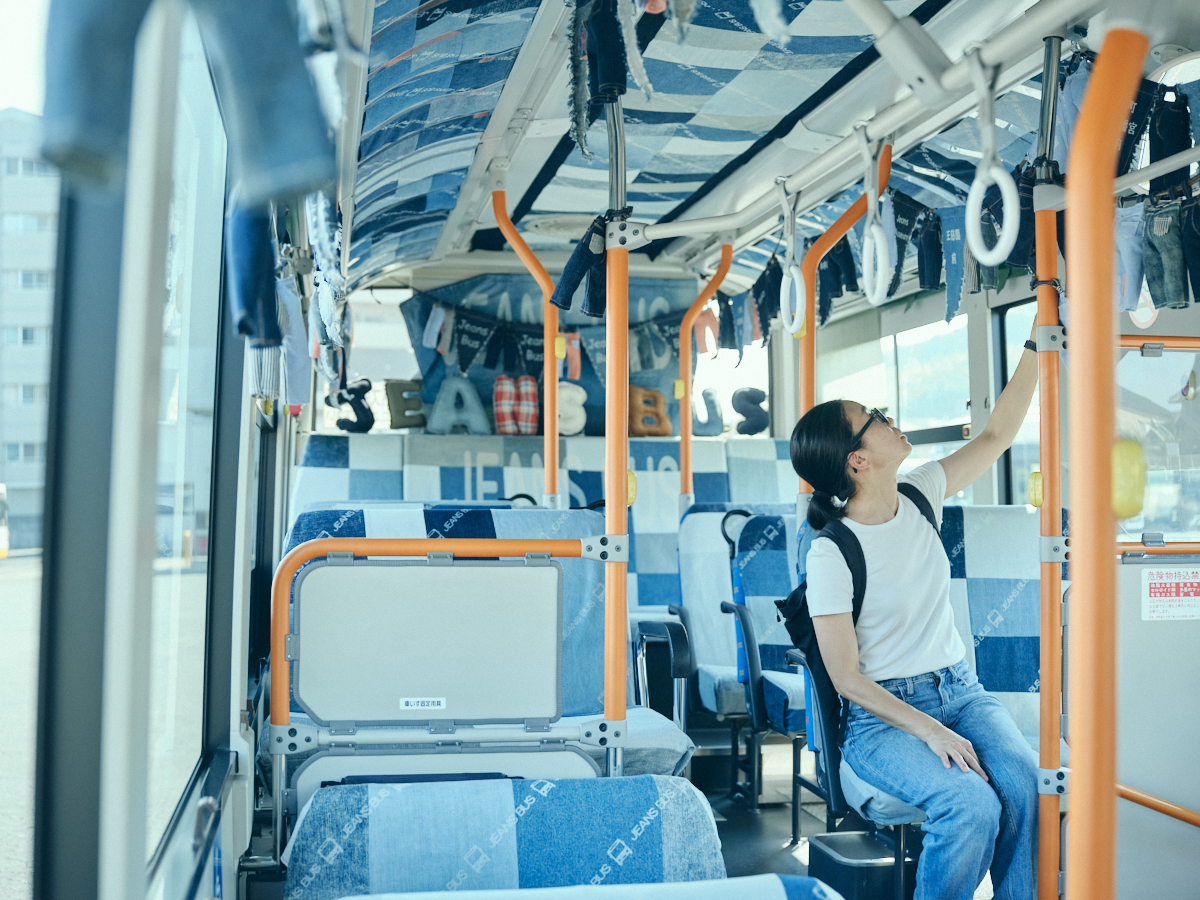 On the jeans bus, passengers learn about the variety of denim fabrics.
On the jeans bus, passengers learn about the variety of denim fabrics.
The best way to explore Kojima is by hopping on the Jeans Bus, which runs six times a day on Fridays, weekends, and holidays (one-day unlimited ride tickets: adults 620 yen, children 310 yen, loop takes about 35 minutes).
The bus is wrapped in denim-inspired designs, and even the seats and destination displays are adorned with denim patchwork—around 15 types in total. True to its “Denim Party” theme, the bus itself builds excitement for the jeans you’ll encounter along the way.
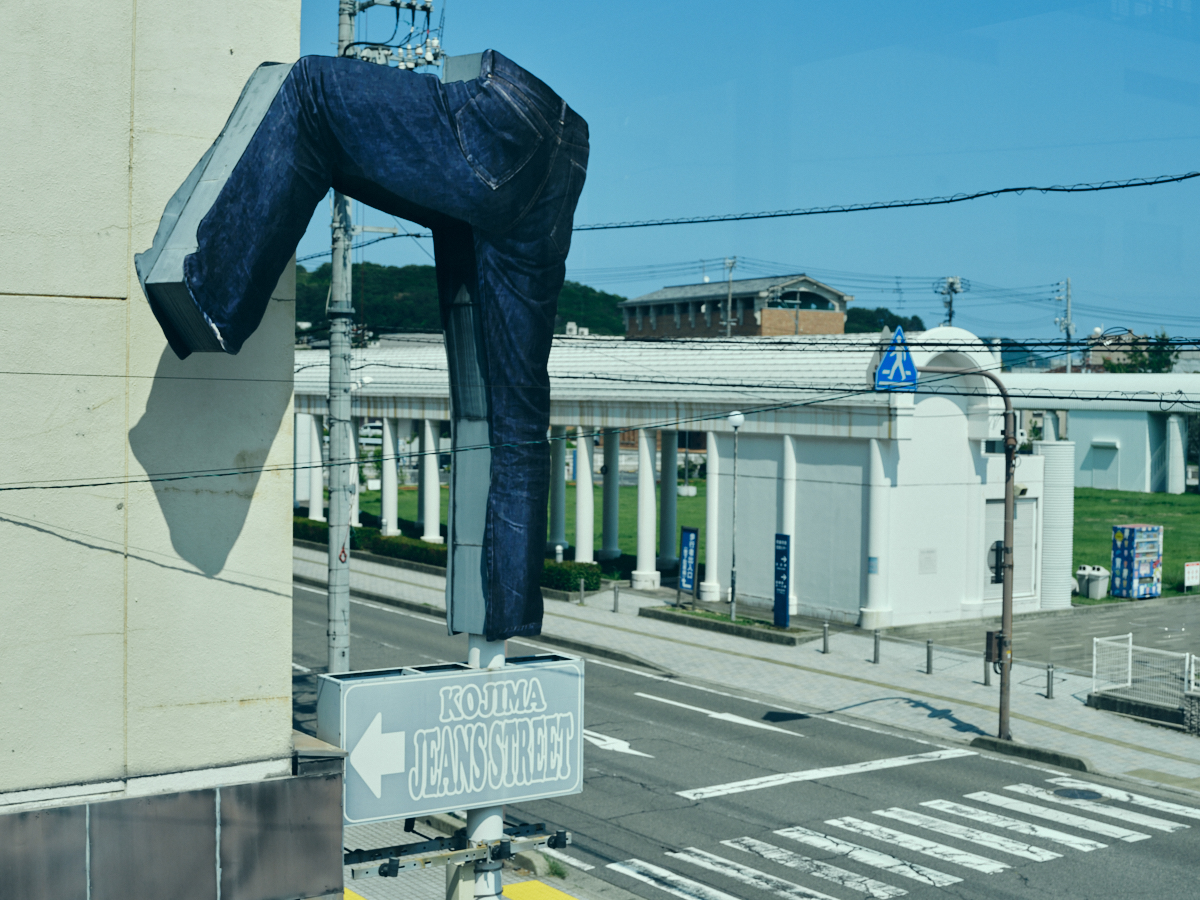 A giant pair of jeans scaling a building marks the way.
A giant pair of jeans scaling a building marks the way.
Stretching about 400 meters, Kojima Jeans Street is lined with distinctive shops. On event days, such as morning markets, you might even find sample items or limited-time bargains for sale.
Kojima Jeans Street is about a five-minute bus ride from Kojima Station to Ajino. Another highlight, the Betty Smith Jeans Museum & Village, is about 15 minutes away by bus, getting off at Jeans Museum Entrance.
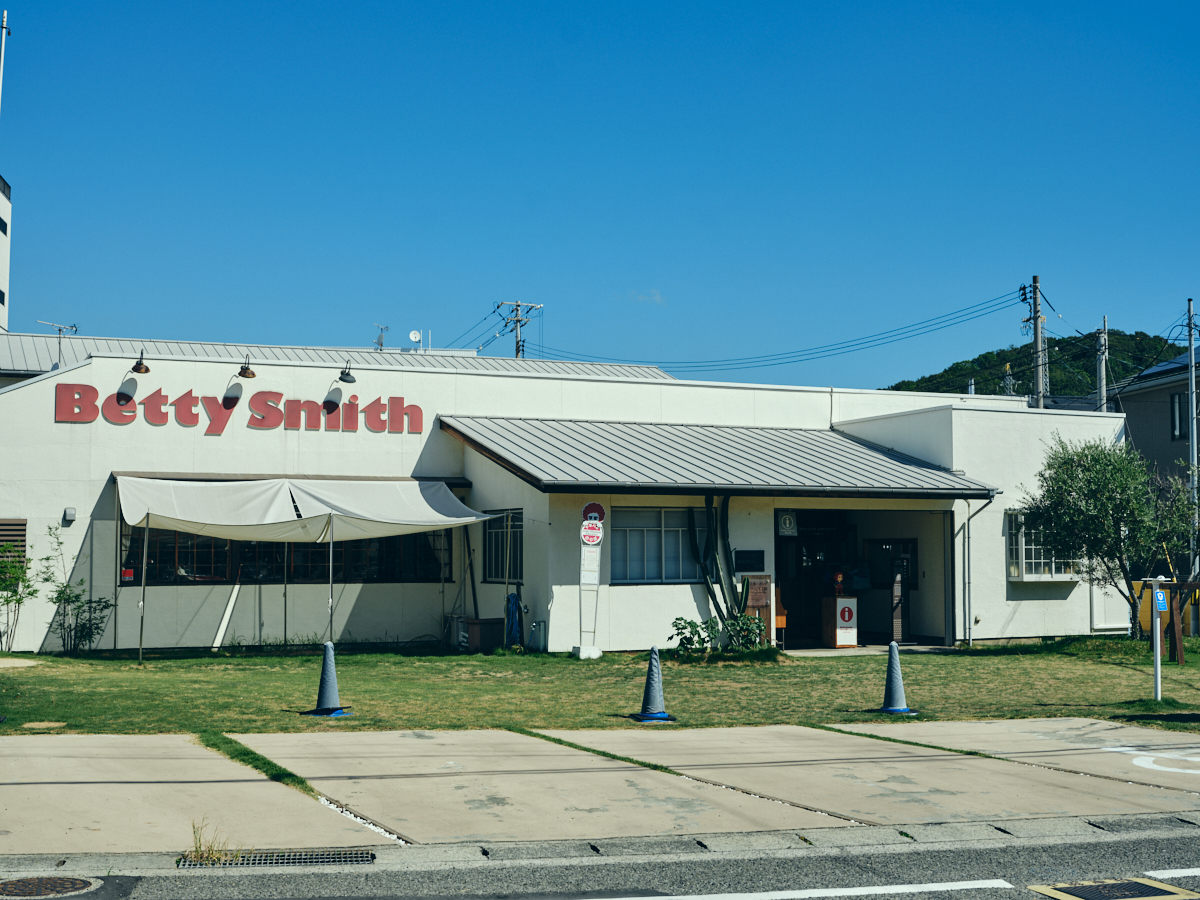 You can also tour Japan’s oldest jeans factory.
You can also tour Japan’s oldest jeans factory.
The Betty Smith Jeans Museum & Village is Japan’s only jeans-themed amusement park. Here you’ll find exhibits on the history and production process of jeans, along with a hands-on workshop, Betty’s Store for shopping, and even a café. You can also commission a pair of custom-made jeans (reservation required), crafted by artisans from fabric of your choosing—your own one-of-a-kind pair.
The hands-on jeans-making experience (reservation required) lets you customize details such as buttons, rivets, and leather patches for a pair of jeans of your choice. The moment you finish your own pair, you’ll not only have an original item but also a deeper connection to Japanese craftsmanship.
Kobe Fashion Museum
Bshop
Eunoia
Onitsuka Tiger
https://www.onitsukatiger.com/jp/ja-jp/
Kakimoto Shoten
https://www.kobe-motomachi.or.jp/shop-search/388
FILTER
https://www.instagram.com/filterkobe/
Jeans Bus
https://shimoden.net/rosen/kikaku/jeans.html
Kojima Jeans Street
Betty Smith





